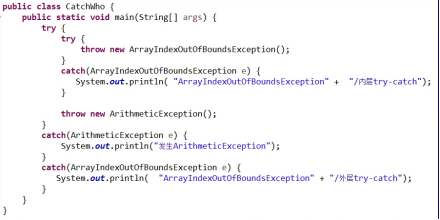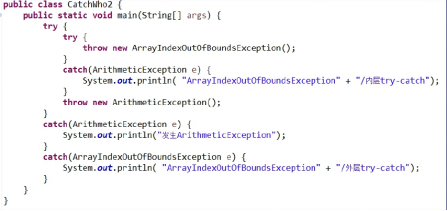04动手动脑
1.请阅读并运行AboutException.java示例,然后通过后面的几页PPT了解Java中实现异常处理的基础知识。
import javax.swing.*;
class AboutException {
public static void main(String[] a)
{
int i=1, j=0, k;
k=i/j;
try
{
k = i/j; // Causes division-by-zero exception
//throw new Exception("Hello.Exception!");
}
catch ( ArithmeticException e)
{
System.out.println("被0除. "+ e.getMessage());
}
catch (Exception e)
{
if (e instanceof ArithmeticException)
System.out.println("被0除");
else
{
System.out.println(e.getMessage());
}
}
finally
{
JOptionPane.showConfirmDialog(null,"OK");
}
}
}

2.阅读以下代码(CatchWho.java),写出程序运行结果:

ArrayIndexOutOfBoundsException/内层try-catch
发生ArithmeticException
3.写出CatchWho2.java程序运行的结果

ArrayIndexOutOfBoundsException/外层try-catch
4.当有多个嵌套的try…catch…finally时,要特别注意finally的执行时机。
请先阅读 EmbedFinally.java示例,再运行它,观察其输出并进行总结。
特别注意:
当有多层嵌套的finally时,异常在不同的层次抛出 ,在不同的位置抛出,可能会导致不同的finally语句块执行顺序。

总结:只有在try语句块的代码中发生错误才会被catch语句块中的代码捕获并处理。不论是否有异常发生,finally语句块中的语句始终保证被执行。
5.辨析:finally语句块一定会执行吗?
请通过 SystemExitAndFinally.java示例程序回答上述问题
public class SystemExitAndFinally {
public static void main(String[] args)
{
try{
System.out.println("in main");
throw new Exception("Exception is thrown in main");
//System.exit(0);
}
catch(Exception e)
{
System.out.println(e.getMessage());
System.exit(0);
}
finally
{
System.out.println("in finally");
}
}
}

当程序提前结束时,finally语句块就不会执行。


 浙公网安备 33010602011771号
浙公网安备 33010602011771号